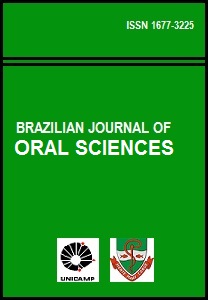Abstract
Candida species have frequently been isolated from the oral cavities of a variety of patients, such as elderly people, dentures users, immunocompromised and health patients. Yeasts may be associated with immune response and local factors such as poor oral hygiene. It was evaluated effectiveness of tongue cleaner showing which types would be preferred by patients, changes in tongue coating and in saliva yeasts counting. Thirty patients were selected and randomly distributed into three groups. This crossover blind study evaluated the effect of tongue cleaning using: a plastic and a steel tongue scraper and a nylon soft-bristle toothbrush. All patients were instructed to use the cleaners twice a day for one week (fifteen-day wash-out period). Saliva and tongue coating samples were collected from each patient from each test period, the yeasts were counted by colony forming units per mL (CFU/mL) and the species were identified. The patients were questioned about cleaner preference. An increase in the percentage of patients with no tongue coating after scraping was observed. A reduction in the mean number of Candida species in tongue coating was observed only after nylon soft-bristle toothbrush cleaner. Candida albicans was the prevalent species. Volunteers preferred to the steel tongue scraper (60%). Tongue cleaners reduced the tongue coating and the mean number of saliva’s yeasts. Degree of tongue coating favors the Candida species colonizationReferences
Epstein JB. Antifugal therapy in oropharyngeal mycotic infections. Oral Surg Oral Med Oral Pathol. 1990; 69: 32-41.
Manfredi R, Calza L, Chiodo F. Dual Candida albicans and Cryptococcus neoformans fungaemia in an AIDS presenter: a unique disease association in the highly active antiretroviral therapy (HAART) era. J Med Microbiol. 2002; 51: 1135-7.
Abu-Elteen KH, Abu-Alteen RM. The prevalence of Candida albicans populations in the mouths of complete denture wearers. New Microbiol. 1998; 21: 41-8.
Ghannoum MA, Radwan SS. Candida adherence to epithelial cells. Boca Raton, FL: CRC Press; 1990.
Dreizen S. Oral candidiasis. Am J Med. 1984; 30: 28-33.
Gómez SM, Danser MM, Sipos PM, Rowshani B, van der Velden U, van der Weijden GA. Tongue coating and salivary bacterial counts in healthy/gingivitis subjects and periodontitis patients. J Clinical Periodontol. 2001; 28: 970.
Guida RA. Candidiasis of the oropharynx and oesophagus. Ear Nose Throat J. 1988; 67: 832-40.
Bosy A, Kulkarni GG, Rosenberg M, McCulloch CAG. Relationship of oral malodor to periodontitis: evidence of independence in discrete subpopulations. J Periodontol. 1994; 65: 37-46.
Quirynen M, Mongardini C, van Steenberghe D. The effect of a one stage full-mouth disinfection on oral malodor and microbial colonization of the tongue in periodontitis patients. J Periodontol. 1998; 69: 374-82.
Quirynen M, Avontroodt P, Soers C, Zhao H, Pauwels M, van Steenberghe D. Impact of tongue cleansers on microbial load and taste. J Clin Periodontol. 2004; 31: 506-10.
Yaegaki K, Sanada K. Biochemical and clinical factors influencing oral malodorin periodontal patients. J Periodontol. 1992; 63a: 783-9.
Yaegaki K, Coil JM. Examination, classification, and treatment of halitosis; clinical perspectives. J Can Dent Assoc. 2000; 66: 257-61.
Bosy A, Kulkarni GG, Rosenberg M, McCulloch CAG. Relationship of oral malodor to periodontitis: evidence of independence in discrete subpopulations. J Periodontol. 1994; 65: 37-46.
Pedrazzi V, Sato S, de Mattos M da G, Lara EH, Panzeri H. Tongue cleaning methods: a comparative clinical trial employing a toothbrush and a tongue scraper. J Periodontol. 2004; 75: 1009-12.
Rowley EJ, Schuchman LC, Tishk MN, Carlson HC. Tongue brushing versus tongue scraping. Clin Prev Dent. 1987; 9: 13-6.
Tonzetich J. Production and origin of oral malodor: a review of mechanisms and methods of analysis. J Periodontol. 1977; 48: 13-20.
Rosemberg M.. Bad breath, diagnosis and treatment. Univ Tor Dent J. 1990; 3: 7-11.
Beighton D, Ludford R, Clark DT, Brailsford SR, Pankhurst CL, Tinsley GF et al. Use of CHROMagar Candida medium for isolation of yeasts from dental samples. J Clin Microbiol. 1995; 33: 3025-7.
Sandven P. Laboratory identification and sensitivity testing of yeast isolates. Acta Odontol Scand. 1990; 48: 27-36.
Gilmore EL, Bhaskar SN. Effect of tongue brushing on bacteria and plaque formed in vitro. J Periodontol. 1972; 43: 418-22.
Gilmore ND, Clark RE. Comparison of wet weight of plaque and a plaque index. J Dent Res. 1975; 54: 422.
Menon MV, Coykendall AL. Effect of tongue scraping. J Dental Research. 1995; 73: 1492.
Quirynen M, Mongardini C, Pauwels M, Bollen CM, Van Eldere J, van Steenberghe D. One stage full- versus partial-mouth disinfection in the treatment of chronic adult or generalized early-onset periodontitis. II. Long-term impact on microbial load. J Periodontol. 1999; 70: 646-56.
Farah CS, Ashman RB, Challacombe SJ. Oral candidosis. Clin Dermatol. 2000; 18: 553-62.
Manfredi R, Calza L, Chiodo F. Dual Candida albicans and Cryptococcus neoformans fungaemia in an AIDS presenter: a unique disease association in the highly active antiretroviral therapy (HAART) era. J Med Microbiol. 2002; 51: 1135-7.
The Brazilian Journal of Oral Sciences uses the Creative Commons license (CC), thus preserving the integrity of the articles in an open access environment.

